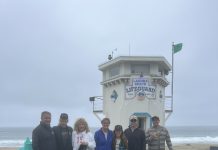On the Front Lines

We’ve talked a lot about the difficulties applicants have navigating the plan check process at city hall and their frustrations at Design Review. But this past week I had the opportunity to attend a Design Review meeting—from 6 p.m. until after midnight—that reminded me of another important part of this process—the neighbors.
Neighbors of applicants have often been portrayed as selfish NIMBY’s who want to gain or preserve every inch of view regardless of the consequences to the applicants’ designs. But neighbors are also in the front lines pushing for implementation of critical city policies that seek to preserve the character of our community, protect neighborhoods, save trees and other vegetation, keep down the noise, and reduce the glare of harsh lighting. Without them, no one with a public interest would be watching. In many ways, the neighbors represent the interests of all of the rest of us who have not received a notice of a hearing and are largely unaware of most of these projects and the cumulative threats to our Laguna, should many of these proposals go forward as originally proposed.
Without neighborhood involvement, the Design Review Board alone would be trying to hold the line on policies that affect the overall welfare of the community—while they are under constant pressure from applicants and their representatives to look at issues from the points of view of their clients.
The neighbors question both what the applicants propose, but also what design changes the city staff, mainly the fire department, have made the applicants incorporate into the design.
I spoke on their behalf at the meeting. We asked, in this case at Diamond/Crestview, for the city to be more flexible in its requirements to remove all the existing vegetation and trees from the property. It wasn’t the applicant’s choice. Their original submittal kept most of these plants.
It’s not a choice between public safety and taste, as some said in the hearing. We can balance fire safety and slope stability and habitat and need for shade and views and guard against climate change by keeping and increasing carbon-absorbing plants, and many other considerations.
There’s enough beauty and Laguna atmosphere for both applicants and neighbors, but the board and the community as a whole have to have the ability to balance all the factors involved. When one of these important factors predominates, public safety and important community issues suffer.
That is what is happening in cases where the fire department trumps all other factors. Right now the fire department dictates, over-riding all other considerations.
The lot in question, replete with lemonade berries, toyon, two large Eucalyptus (all termed “target species” by the fire marshal) and other vegetation will be stripped bare, exposing it to erosion and slope instability, as well as being in violation of the adopted Diamond/Crestview policy to maintain “significant areas of natural open space while building residences that nestle into the hillsides, separated by native growth, foliage and trees.”
Even if the fire consideration is paramount, the decisions regarding what is a firesafe project rests solely with one person—the fire marshal. The interpretations he makes should be subject to question. Some are in violation of adopted city policies—for example, fuel modification requirements are for fuel modification zones, not for individual lots surrounded by other houses. (See Action 6.1.4 of the recently adopted Landscape and Scenic Highways Element.) Therefore, the fuel modification criteria imposed on this project was wrongly applied.
The fire department has designated “target species” (plants required to be removed) within fuel modification zones. This not based in science. There is no study that demonstrates that a toyon or a lemonade berry burns more readily than the replacement plants that are on a list of approved plants, also not scientifically evaluated to be better. The state agency, Calfire, doesn’t endorse the concept of “target species” at all, saying that maintenance to remove dead materials and moisture levels in the vegetation are more important than the plant species. In addition, the city’s guidelines on fuel modification have recently been replaced with guidelines that do not include “target species.” Yet, at that meeting, the fire marshal continued to invoke presence of plants on the “target species” list as a reason for the fire department’s insistence that certain plants be removed.
The project was approved on a 3-2 vote without the vegetation preservation the neighbors advocated.
Later in the agenda other neighbors expressed concern about a very large house on Oriole Drive. They spoke of the quiet, dark and small-scaIe character of their neighborhood, objecting to the nearly 7,000 square foot structure with over 1,600 square feet of decks stepping with multiple levels down the slope. If that building were to be constructed as shown, I can hear the outrage now, “How did that get approved?” The board pushed for changes and the project will be coming back for an additional hearing.
Last on the agenda—after 11 p.m.—a proposed pool on the rear slope of a house on Mar Vista Avenue was reviewed for the second time. A crowd of patient down hill neighbors spoke of the highly visible mass of the tall retaining walls needed to support the pool, the noise from this new outdoor activity. They urged the board to stick with the recently DR-approved landscape plan that plants a screening buffer on the slope—without a pool and its impacts. Another 3-2 vote approved the applicant’s proposal, with larger trees to be planted between the pool and the neighbors.
Thank you, neighbors, for representing the rest of us. Without your diligence and concern, our town would be changing even more drastically away from the Laguna we love.
Ann Christoph is a landscape architect and former mayor and member of the City Council.




